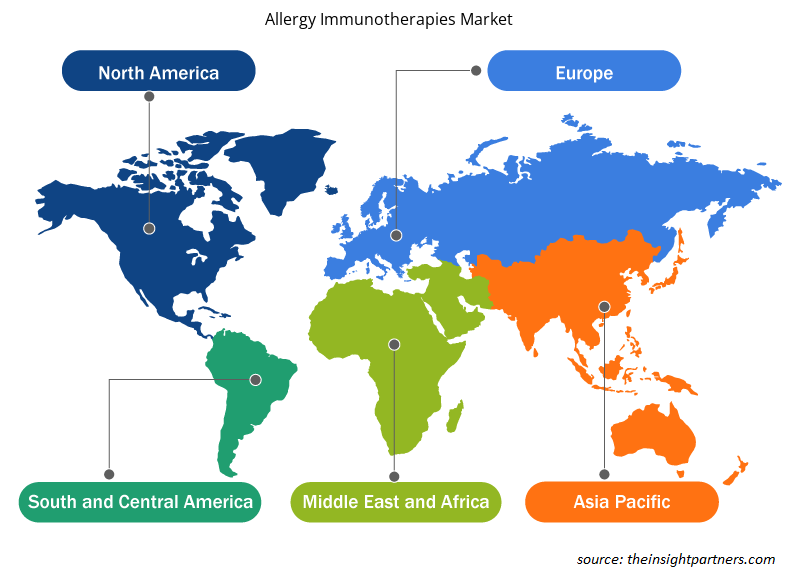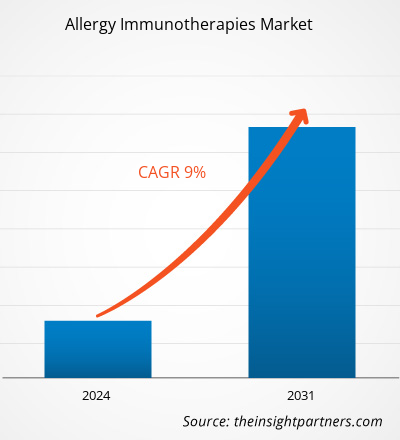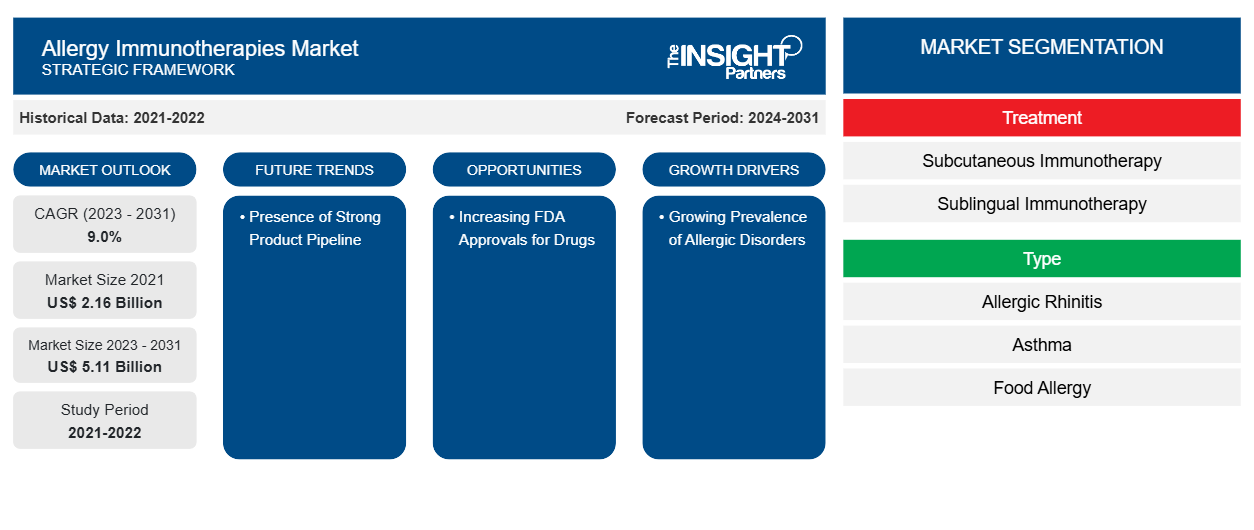تم تقدير سوق علاجات المناعة للحساسية بنحو 2.16 مليار دولار أمريكي في عام 2021 وxx مليار دولار أمريكي في عام 2023. ومن المتوقع أن يصل إلى 5.11 مليار دولار أمريكي بحلول عام 2031 ويسجل معدل نمو سنوي مركب بنسبة 9.0٪ حتى عام 2031. ومن المرجح أن يظل تطوير طرق توصيل جديدة وظهور العلاجات المركبة والتقدم في الطب الشخصي من الاتجاهات الرئيسية لسوق علاجات المناعة للحساسية.
تحليل سوق علاجات الحساسية المناعية
من المتوقع أن يؤدي الانتشار المتزايد للاضطرابات التحسسية في جميع أنحاء العالم إلى دفع نمو سوق علاجات الحساسية المناعية. يتطلب الانتشار المتزايد للاضطرابات التحسسية العلاج المناعي للحساسية، وهو علاج آمن وفعال ضد مسببات الحساسية مثل العفن الحشري وحبوب اللقاح والحيوانات، وكذلك الربو التحسسي. وفقًا للكلية الأمريكية للحساسية والربو والمناعة، في عام 2021، أفاد 1 من كل 3 بالغين وأكثر من 1 من كل 4 أطفال في الولايات المتحدة بوجود حساسية موسمية أو أكزيما أو حساسية تجاه الطعام.
إن الانتشار المتزايد للحساسية في جميع أنحاء العالم يزيد من الطلب العالمي على العلاجات المناعية، مما يعزز نمو السوق.
نظرة عامة على سوق علاجات الحساسية المناعية
تم تقسيم سوق العلاجات المناعية للحساسية العالمية حسب المنطقة إلى أمريكا الشمالية وأوروبا وآسيا والمحيط الهادئ والشرق الأوسط وأفريقيا وأمريكا الجنوبية والوسطى. ومن المتوقع نمو السوق في هذه المنطقة بسبب عوامل مثل الانتشار المتزايد للاضطرابات التحسسية والتقدم التكنولوجي في تركيبات الجرعات تحت اللسان. ومع ذلك، من المرجح أن تعيق العيوب المرتبطة باستخدام العلاجات المناعية للحساسية والاختلافات التنظيمية عبر المناطق نمو السوق خلال فترة التوقعات.
قم بتخصيص هذا التقرير ليناسب متطلباتك
ستحصل على تخصيص لأي تقرير - مجانًا - بما في ذلك أجزاء من هذا التقرير، أو تحليل على مستوى الدولة، وحزمة بيانات Excel، بالإضافة إلى الاستفادة من العروض والخصومات الرائعة للشركات الناشئة والجامعات
-
احصل على أهم اتجاهات السوق الرئيسية لهذا التقرير.ستتضمن هذه العينة المجانية تحليلاً للبيانات، بدءًا من اتجاهات السوق وحتى التقديرات والتوقعات.
محركات وفرص سوق علاجات الحساسية المناعية
من المرجح أن يؤدي الوعي المتزايد بشأن علاج الحساسية إلى صالح السوق.
إن زيادة الوعي العام بشأن الحساسية وخيارات إدارتها يؤدي إلى زيادة الطلب على علاجات أفضل. ويسعى الناس إلى التخلص من الأعراض التي قد تؤثر بشكل كبير على جودة حياتهم.
احتفلت إدارة مراقبة التعليم بالولاية وقسم الصحة والعافية بأسبوع التوعية بحساسية الطعام في الفترة من 14 مايو إلى 20 مايو 2023. وركزت الحملة على تثقيف ورفع مستوى الوعي حول حساسية الطعام والحساسية المفرطة.
وجود خط إنتاج قوي – فرصة في سوق علاجات المناعة للحساسيةImmunotherapies Market
يتألف خط إنتاج العلاج المناعي للحساسية من 15 علاجًا في مراحل سريرية مختلفة من التطوير. ومن بين الجهات المشاركة في تطوير العلاجات المناعية للأمراض التحسسية شركة Aimmune Therapeutics Inc.، وDBV Technologies SA، وGenentech Inc.، وASIT biotech SA، وInmunotek SL، وAnergis SA، وBiomay AG، وRegeneron Pharmaceuticals Inc.
تدعم النتائج السريرية الإيجابية للعلاجات المناعية المختلفة التي تخضع للتجارب السريرية تطوير أدوية تعتمد على العلاج المناعي للحساسية. على سبيل المثال، في نوفمبر 2022، منحت إدارة الغذاء والدواء (FDA) تصنيف المسار السريع لـ ADP101 من Alladapt Immunotherapeutic - وهو علاج مناعي فموي تجريبي لعلاج واحد أو أكثر من أكثر مسببات الحساسية الغذائية أهمية
تقرير تحليل تجزئة سوق علاجات الحساسية المناعية
إن القطاعات الرئيسية التي ساهمت في اشتقاق تحليل سوق علاجات الحساسية المناعية هي الخدمات والتطبيقات.
- بناءً على العلاج، يتم تقسيم سوق علاجات الحساسية المناعية إلى العلاج المناعي تحت الجلد (SCIT) والعلاج المناعي تحت اللسان (SLIT). في عام 2023، استحوذ قطاع العلاج المناعي تحت الجلد (SCIT) على أكبر حصة من السوق. علاوة على ذلك، من المتوقع أن ينمو قطاع العلاج المناعي تحت اللسان (SLIT) بأسرع معدل خلال فترة التنبؤ.
- بحسب نوع الحساسية، يتم تقسيم سوق علاجات الحساسية المناعية إلى التهاب الأنف التحسسي، والربو، وحساسية الطعام، وحساسية السموم، وغيرها. احتل قطاع التهاب الأنف التحسسي الحصة الأكبر من السوق في عام 2023، ومن المتوقع أن يسجل نفس القطاع أعلى معدل نمو سنوي مركب في السوق خلال فترة التوقعات.
- تم تقسيم سوق علاجات الحساسية المناعية حسب قناة التوزيع إلى صيدلية المستشفيات وصيدلية التجزئة والصيدلية عبر الإنترنت. في عام 2023، استحوذ قطاع إعدادات صيدلية المستشفيات على أكبر حصة من السوق حسب قناة التوزيع. علاوة على ذلك، من المتوقع أن ينمو نفس القطاع بشكل أسرع خلال فترة التوقعات.
تحليل حصة سوق علاجات الحساسية المناعية حسب المنطقة الجغرافية
ينقسم النطاق الجغرافي لتقرير سوق علاجات الحساسية المناعية بشكل أساسي إلى خمس مناطق: أمريكا الشمالية، ومنطقة آسيا والمحيط الهادئ، وأوروبا، والشرق الأوسط وأفريقيا، وأمريكا الجنوبية/أمريكا الجنوبية والوسطى.
تشمل أمريكا الشمالية الولايات المتحدة وكندا والمكسيك. تمتلك أمريكا الشمالية الحصة الأكبر في سوق علاجات المناعة للحساسية، حيث تمتلك الولايات المتحدة أكبر حصة في السوق، تليها كندا. تمتلك الولايات المتحدة أكبر حصة في سوق علاجات المناعة للحساسية المنسوبة إلى الانتشار المتزايد للاضطرابات التحسسية، وبالتالي زيادة الطلب على علاجات المناعة للحساسية وتغذية نمو السوق. علاوة على ذلك، فهي المقر الرئيسي للعديد من الشركات المصنعة العاملة في تصنيع علاجات المناعة للحساسية، مما يدفع نمو السوق في البلاد. علاوة على ذلك، أدى ارتفاع وعي المستهلك بشأن علاج الحساسية إلى زيادة الطلب على الأكسجين التكميلي الصحي في أمريكا الشمالية.
من المتوقع أن تكون منطقة آسيا والمحيط الهادئ هي المنطقة الأسرع نموًا بين جميع المناطق الأخرى. ومن المتوقع أن ينمو نمو السوق في منطقة آسيا والمحيط الهادئ بوتيرة أسرع بسبب عوامل مثل ارتفاع معدل انتشار أمراض الحساسية والمناعة في دول مثل أستراليا والهند وغيرها. علاوة على ذلك، من المتوقع أن توفر المبادرات المتزايدة التي تتبناها الحكومة من حيث استراتيجيات الوقاية والعلاج سيناريو نمو مربح للسوق في المنطقة. بالإضافة إلى ذلك، من المتوقع أن يؤدي تطوير البنية التحتية للرعاية الصحية وزيادة الاستثمارات لتعزيز الأنشطة البحثية إلى دفع سوق علاجات الحساسية المناعية في منطقة آسيا والمحيط الهادئ خلال فترة التنبؤ.
علاجات الحساسية المناعية
رؤى إقليمية حول سوق علاجات الحساسية المناعية
لقد قام المحللون في Insight Partners بشرح الاتجاهات والعوامل الإقليمية المؤثرة على سوق علاجات الحساسية المناعية طوال فترة التوقعات بشكل شامل. يناقش هذا القسم أيضًا قطاعات سوق علاجات الحساسية المناعية والجغرافيا في جميع أنحاء أمريكا الشمالية وأوروبا ومنطقة آسيا والمحيط الهادئ والشرق الأوسط وأفريقيا وأمريكا الجنوبية والوسطى.

- احصل على البيانات الإقليمية المحددة لسوق علاجات الحساسية المناعية
نطاق تقرير سوق علاجات الحساسية المناعية
| سمة التقرير | تفاصيل |
|---|---|
| حجم السوق في عام 2021 | 2.16 مليار دولار أمريكي |
| حجم السوق بحلول عام 2031 | 5.11 مليار دولار أمريكي |
| معدل النمو السنوي المركب العالمي (2023 - 2031) | 9.0% |
| البيانات التاريخية | 2021-2022 |
| فترة التنبؤ | 2024-2031 |
| القطاعات المغطاة |
حسب العلاج
|
| المناطق والدول المغطاة |
أمريكا الشمالية
|
| قادة السوق وملفات تعريف الشركات الرئيسية |
|
كثافة اللاعبين في سوق علاجات المناعة للحساسية: فهم تأثيرها على ديناميكيات الأعمال
يشهد سوق علاجات الحساسية المناعية نموًا سريعًا، مدفوعًا بالطلب المتزايد من جانب المستخدم النهائي بسبب عوامل مثل تفضيلات المستهلكين المتطورة والتقدم التكنولوجي والوعي المتزايد بفوائد المنتج. ومع ارتفاع الطلب، تعمل الشركات على توسيع عروضها والابتكار لتلبية احتياجات المستهلكين والاستفادة من الاتجاهات الناشئة، مما يؤدي إلى زيادة نمو السوق.
تشير كثافة اللاعبين في السوق إلى توزيع الشركات أو المؤسسات العاملة في سوق أو صناعة معينة. وهي تشير إلى عدد المنافسين (اللاعبين في السوق) الموجودين في مساحة سوق معينة نسبة إلى حجمها أو قيمتها السوقية الإجمالية.
الشركات الرئيسية العاملة في سوق علاجات الحساسية المناعية هي:
- شركة أيه إل كيه-أبيلو إيه/إس
- علوم الصحة في نستله
- ليتيفارما
- ستاليرجين جرير
- هال للحساسية BV
- شركة جونسون آند جونسون للخدمات المحدودة
إخلاء المسؤولية : الشركات المذكورة أعلاه ليست مرتبة بأي ترتيب معين.

- احصل على نظرة عامة على أهم اللاعبين الرئيسيين في سوق علاجات الحساسية المناعية
أخبار سوق علاجات الحساسية المناعية والتطورات الأخيرة
يتم تقييم سوق علاجات المناعة للحساسية من خلال جمع البيانات النوعية والكمية بعد البحث الأولي والثانوي، والتي تتضمن منشورات الشركات المهمة وبيانات الجمعيات وقواعد البيانات. فيما يلي قائمة بالتطورات في سوق علاجات المناعة للحساسية والاستراتيجيات:
- في أغسطس 2020، استحوذت شركة نستله هيلث ساينس على شركة Aimmune Therapeutics. ومن شأن العلاج المعتمد من شركة Aimmune، Palforzia، أن يوسع محفظة نستله هيلث ساينس من خلال العلاج الأول والوحيد المعتمد من إدارة الغذاء والدواء للمساعدة في تقليل تكرار وشدة ردود الفعل التحسسية تجاه الفول السوداني لدى الأطفال. (المصدر: بيان صحفي للشركة)
- في سبتمبر 2023، أبرمت شركة Stallergenes Greer اتفاقية مع شركة Nestlé Health Science للاستفادة من علاج Palforzia المناعي الفموي لحساسية الفول السوداني. (المصدر: بيان صحفي للشركة)
تغطية تقرير سوق العلاجات المناعية للحساسية والمنتجات النهائية
يوفر تقرير "حجم سوق علاجات الحساسية المناعية والتوقعات (2021-2031)" تحليلاً مفصلاً للسوق يغطي المجالات التالية:
- حجم السوق والتوقعات على المستويات العالمية والإقليمية والوطنية لجميع قطاعات السوق الرئيسية التي يغطيها النطاق
- ديناميكيات السوق مثل المحركات والقيود والفرص الرئيسية
- الاتجاهات المستقبلية الرئيسية
- تحليل مفصل لقوى PEST/Porter الخمس وSWOT
- تحليل السوق العالمي والإقليمي الذي يغطي اتجاهات السوق الرئيسية واللاعبين الرئيسيين واللوائح والتطورات الأخيرة في السوق
- تحليل المشهد الصناعي والمنافسة الذي يغطي تركيز السوق، وتحليل خريطة الحرارة، واللاعبين البارزين، والتطورات الأخيرة
- ملفات تعريف الشركة التفصيلية
- التحليل التاريخي (سنتان)، سنة الأساس، التوقعات (7 سنوات) مع معدل النمو السنوي المركب
- تحليل PEST و SWOT
- حجم السوق والقيمة / الحجم - عالمي، إقليمي، بلد
- الصناعة والمنافسة
- مجموعة بيانات إكسل
التقارير الحديثة
شهادات العملاء
سبب الشراء
- اتخاذ قرارات مدروسة
- فهم ديناميكيات السوق
- تحليل المنافسة
- رؤى العملاء
- توقعات السوق
- تخفيف المخاطر
- التخطيط الاستراتيجي
- مبررات الاستثمار
- تحديد الأسواق الناشئة
- تحسين استراتيجيات التسويق
- تعزيز الكفاءة التشغيلية
- مواكبة التوجهات التنظيمية























 احصل على عينة مجانية ل - سوق علاجات الحساسية المناعية
احصل على عينة مجانية ل - سوق علاجات الحساسية المناعية